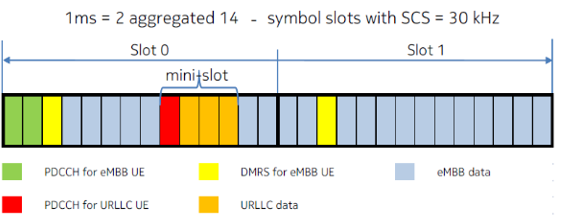As well known, NR is using slot based scheduling which is with 14 OFDM symbols & it’s duration scales with the subcarrier spacing.
But also, in NR we have what is called Type B scheduling “mini-slot”
Interviewer: what is the mini-slot in NR?
Interviewee: it the minimum scheduling unit in 5G with 2, 4, 7 OFDM symbols.
Interviewer: What is the gain of using it?
Interviewee:
This provides fast transmission opportunities, for example, URLLC traffic that is not restricted by slot boundaries. Thus, mini-slots provide a viable solution to low-latency transmissions irrespective of sub-carrier spacing.
In the example of resource allocation shown, you can see a Mini-slot of 4 OFDM symbols allocated to URLLC User Equipment: one symbol in red to carry the PDCCH and 3 symbols (orange) for data traffic transmission.
And hence Mini-slot can over-write a longer allocation & also allows multiplexing of MBB and URLLC use cases.
Interviewer: so how the mini-slot is defined?
Interviewee:
Mini-slot is defined by:
K –> identifies the slot
S –> identifies the starting symbol relative to the start of the slot
L –> identifies the number of consecutive symbols counting from S
#Enjoy_5G_Learning_#9

3 Likes
Thanks for the write up. Is the mini-slot feature matured enough to be deplyed in the field? AFAIK, no operator is implementing this as of now.
Thanks & welcome pradeep.
As you know, 5G features are still ongoing & all vendors are running on the track to achieve all 5G 3gpp.specs.
As far as i know, This feature is not available yet by any vendor.
-
A mini-slot in 5G is a new concept that allows for low latency communication and is the minimum scheduling unit used in 5G NR.
-
Mini-slots can contain 7, 4, or 2 OFDM symbols, regardless of numerology.
-
They can start immediately without needing to wait for slot boundaries, enabling quick delivery of low-latency payloads.
-
Mini-slots are not only useful for low-latency applications, but they also play an important role in LTE-NR coexistence and beamforming.
-
Mini-slots enable non-slot based scheduling, which has higher priority than normal eMBB user and can pre-empt other eMBB transmissions as it has requirements for lower latency.
-
Mini-slots help to achieve lower latency in 5G NR architecture.
-
A mini-slot transmission can last only as many symbols as required for communication, which minimizes interference to other RF links.

Mini-slot: optimized for shorter data transmissions, e.g. URLLC
LinkedIn: 

